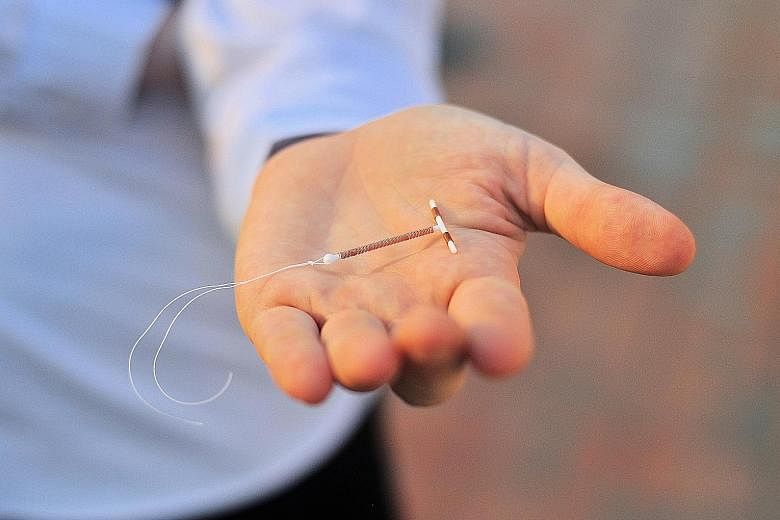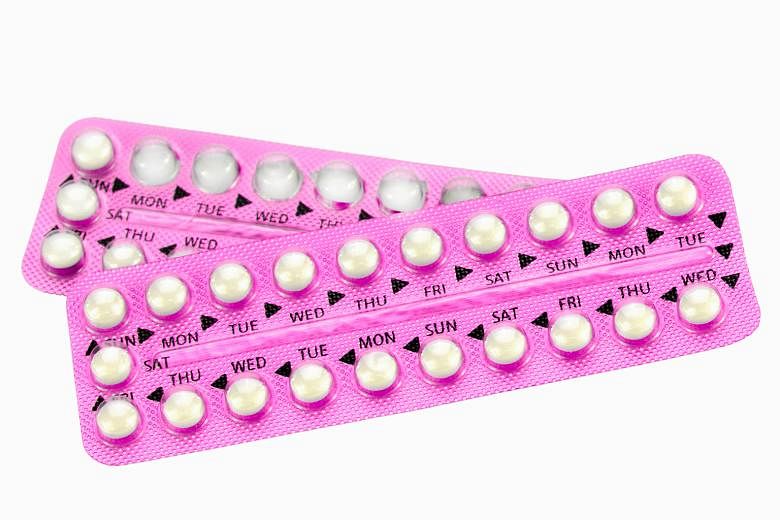Today, safe and proven methods of birth control - from injections and pills to even an app - are readily available, but not everyone is aware of them.
Obstetrician and gynaecologist Christopher Ng of GynaeMD Women's and Rejuvenation Clinic said the pill, for instance, is underused here, even though it is more effective in preventing pregnancy than condoms.
"Many women shy away from using oral contraceptives because they have misconceptions about how taking hormones is bad for them or that it can lead to infertility later on," he said.
In Singapore, the male condom remains one of the most popular contraceptive options, experts said.
Dr Christopher Chong, an obstetrician, gynaecologist and urogynaecologist at Chris Chong Clinic, said it is up to 98 per cent effective in preventing pregnancy, but the figure drops drastically when used incorrectly.
To be safe, there should be no direct contact between the penis and the vagina before the condom is worn.

"This is because pre-ejaculation secretions may even be higher in sperm count than the actual ejaculation itself," said Dr Chong. He added that it is also important to "squeeze the air pocket at the tip of the condom" before putting it on, to prevent tearing.
Here's a look at the various contraceptive options.
•This article first appeared in Young Parents magazine. Young Parents, published by SPH Magazines, is available in digital and print formats. Go to www.youngparents.com.sg to subscribe and for more stories.
Long-term options
CONTRACEPTIVE IMPLANT
What: Inserted under the arm to prevent ovulation, this progesterone implant slowly releases hormones to prevent pregnancy.
How effective: Up to 99 per cent.
The good: The implant lasts for three years and is thus a long-term contraceptive option. You will also regain your fertility quickly after you stop using it.
The bad: Weight gain, irregular menses and bloating are some common side effects. You will need to see a doctor to get it inserted.
In rare instances, removing the implant may be a challenge if it is embedded too deeply, said Dr Christopher Chong.
INTRAUTERINE DEVICE (IUD)
What: Also called the coil, this is a small T-shaped copper device which is inserted into the uterus to prevent pregnancy.
How effective: Up to 98 per cent.
The good: This can be left in the womb for up to five years. It is also a good choice for breastfeeding mums. Your fertility resumes once you remove it.
The bad: It may cause irregular bleeding or spotting. Doctors don't usually recommend this as a first choice for anaemic women or those who have heavy periods.
In rare instances, there is a small risk that the IUD may fall out and cause an infection during the insertion, said Dr Wee Horng Yen, an obstetrician and gynaecologist at The O & G Care Clinic.
Other risks include difficulty in removing the device.
MIRENA
What: This small plastic device, which is inserted into the uterus, works like the coil, except that it has an added hormonal (progestogen) effect.
How effective: It works almost like permanent sterilisation and is more than 99 per cent effective, said Dr Wee.
The good: It can stay in place for about five years and fertility resumes once you remove it. Dr Wee said it also helps reduce heavy periods, painful menstrual cramps and symptoms of adenomyosis, a painful gynaecological condition.
About one in five women who have been on the Mirena for six months will have no periods or have only light staining.
The bad: You may bleed a lot in the first three months, warned Dr Chong. The Mirena carries similar risks as the IUD.
TUBAL LIGATION
What: A form of contraception where the fallopian tubes - which carry eggs from the ovaries to the womb - are surgically cut.
How effective: More than 99 per cent effective.
The good: It is for women who are certain that they no longer want more children.
The bad: Most doctors do not recommend this procedure. In one in 200 cases, the procedure doesn't work out and the woman ends up pregnant, said Dr Wee.
Some women who decide on sterilisation regret their decision, he said. "From time to time, some of them would return, asking for a reversal of their fertility."
While the procedure can be reversed, doctors said rejoining the tubes is no mean feat.
The reversal surgery carries risks and a chance that it may end up unsuccessful. "Not only will it not work, you may even end up with a higher risk of ectopic pregnancy after reversing the procedure," Dr Chong said.
Ectopic pregnancy is an abnormal pregnancy that occurs outside the womb.
Dr Chong said there are two important points to consider with this option. One, what if you remarry? Two, what if your child dies or falls seriously ill?
"I've had a patient who went for ligation and, after the procedure, found out that her child had leukaemia."
Short-term options
THE PILL
What: Taken daily, the combined oestrogen and progestogen pill prevents ovulation.
How effective: Up to 99 per cent if used correctly.
The good: This is one of the most effective forms of birth control. Your fertility returns immediately when you stop taking it. Plus, there are other benefits. Dr Wee Horng Yen cited a lower risk of ovarian and endometrial cancer. It also helps regulate the menstrual cycle, manage acne and improve PMS symptoms.
The bad: This can be a hassle for those who hate popping pills as you have to remember to take it every day for it to work properly.
It is not suitable for women with health problems or who are on certain medications.
CONTRACEPTIVE PATCH
What: A thin patch that works in the same manner as the pill.
It is worn anywhere on the abdomen, thigh, buttocks or arm and it is changed weekly.
How effective: Up to 99 per cent if used correctly.
The good: Dr Christopher Chong said it is a good option for those who find pill-popping a hassle.
Users also experience "fewer gastric effects" than those on the pill.
The bad: It is not transparent. Plus, Dr Christopher Ng said, it can get a tad annoying and uncomfortable, thanks to Singapore's hot and humid weather.
"There's also a psychological effect. Some women get insecure because they are not sure if it will fall off," Dr Ng added.
CONTRACEPTIVE INJECTION
What: A shot in the buttocks or arm to prevent ovulation.
How effective: Up to 99 per cent.
The good: You have to do this only once every three months. Dr Wee said it is suitable for breastfeeding mums. There is light or possibly no periods after a year.
The bad: Weight gain and irregular bleeding in the first three months are common side effects. You may also end up forgetting to take your shots.
Dr Ng said you may have to wait six to 12 months to regain fertility after you stop the injections.
NATURAL CYCLES APP
What: This smartphone fertility- tracking app is the first to be government-approved as a contraceptive, putting it alongside the pill, coils and condoms, in Europe, at least.
How effective: A clinical study has proven that using the app is as effective as being on the pill.
The good: There are no side effects as no medication is involved. To use it, women measure the temperature under their tongues every morning and enter the measurement into the app.
An algorithm developed for the app then determines if you are fertile that day, so you know if you will risk pregnancy by having unprotected sex.
The bad: Critics said this fertility- based awareness method of contraception isn't always reliable as our bodies could be affected by various factors, including stress.


